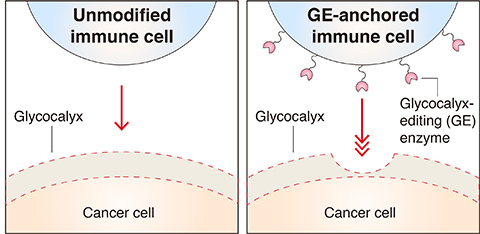Thicker glycocalyx barrier helps cancer evade immune system
One of the ways that cancer cells hide from the body’s immune system is by forming a thin surface barrier called the glycocalyx. In a new study, researchers examined the material properties of this barrier with unprecedented resolution, revealing information that could help improve current cell-based cancer immunotherapies.

Cancer cells often form the glycocalyx with high levels of cell-surface mucins, which are thought to help protect the cancer cell from immune cell attack. However, a physical understanding of this barrier has remained limited, especially as it relates to cell-based cancer immunotherapies, which involve removing immune cells from a patient, modifying them to seek and destroy cancer, and then putting them back into the patient’s body.
“We found that changes in the thickness of the barrier that were as small as 10 nanometers could affect the antitumor activity of our immune cells or the engineered cells used for immunotherapy,” said Sangwoo Park, a graduate student in Matthew Paszek’s Lab at Cornell University in Ithaca, New York. “We used this information to engineer immune cells that can get through the glycocalyx, and we hope this approach could be used to enhance current cell-based immunotherapies.”
Park will present the findings at Discover BMB, the annual meeting of the American Society for Biochemistry and Molecular Biology, March 25–28 in Seattle.
“Our lab has advanced a powerful strategy called scanning angle interference microscopy (SAIM) for measuring the nanoscale dimensions of the cancer cell glycocalyx,” said Park. “This imaging technique allows us to understand the structural relationship of cancer-associated mucins to the biophysical properties of the glycocalyx.”
The researchers generated a cellular model to precisely control the cell-surface mucin expression to mimic the cancer cell glycocalyx. They then combined SAIM with genetic approaches to study how the surface density, glycosylation and crosslinking of cancer-associated mucins affect the thickness of the barrier at the nanoscale. They also analyzed how the glycocalyx thickness affected a cell’s resistance to attack by immune cells.
The study revealed that the thickness of cancer cells' glycocalyx is one of the major parameters determining immune cell evasion and that engineered immune cells worked better if the glycocalyx was thinner.
Based on this knowledge, the researchers engineered immune cells with special enzymes on their surface to allow them to attach to and interact with the glycocalyx. Experiments performed at the cellular level showed that these immune cells were able to overcome the glycocalyx armor of cancer cells.
Next, the researchers plan to determine whether these findings can be replicated in the laboratory and, eventually, in clinical trials.
Sangwoo Park will present this research during the Regulatory Glycosylation Spotlight Session from 2–3 p.m. PDT on Sunday, March 26, in Room 608 of the Seattle Convention Center (abstract). Contact the media team for more information or to obtain a free press pass to attend the meeting.
Enjoy reading ASBMB Today?
Become a member to receive the print edition monthly and the digital edition weekly.
Learn moreGet the latest from ASBMB Today
Enter your email address, and we’ll send you a weekly email with recent articles, interviews and more.
Latest in Science
Science highlights or most popular articles

New class of antimicrobials discovered in soil bacteria
Scientists have mined Streptomyces for antibiotics for nearly a century, but the newly identified umbrella toxin escaped notice.

New study finds potential targets at chromosome ends for degenerative disease prevention
UC Santa Cruz inventors of nanopore sequencing hail innovative use of their revolutionary genetic-reading technique.

From the journals: JLR
How lipogenesis works in liver steatosis. Removing protein aggregates from stressed cells. Linking plasma lipid profiles to cardiovascular health. Read about recent papers on these topics.

Small protein plays a big role in viral battles
Nef, an HIV accessory protein, manipulates protein expression in extracellular vesicles, leading to improved understanding of HIV-1 pathogenesis.

Genetics studies have a diversity problem that researchers struggle to fix
Researchers in South Carolina are trying to build a DNA database to better understand how genetics affects health risks. But they’re struggling to recruit enough Black participants.

Scientists identify new function of learning and memory gene common to all mammalian brain cells
Findings in mice may steer search for therapies to treat brain developmental disorders in children with SYNGAP1 gene mutations.

